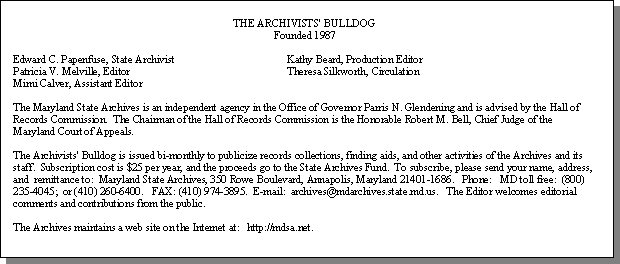|
|
|
|
|
Maryland,
beginning in the l760s, carries its own shining shield of dutiful constancy
and innovative progress. These 240 years are indeed worth reviewing, as
the past contributes immensely to the future. Thus, our topic for this
year's contest is "The Constant Guardian..Maryland Firefighters and Police
in Review"
Her challenge was taken up in
earnest by George Kropp, a teacher at Calvert Hall College High School,
who clearly inspired his class to focus on Baltimore's response to its
own great disaster, the fire of 1904, a topic that another, recently deceased
Marylander of the Year, Harold A. Williams knew well. Hal Williams, recipient
of the 1988 Marylander of the Year award, set the standard for Kropp's
students to follow in his 1954 classic "Baltimore Afire." He would have
enjoyed meeting these students and reading their essays. He probably would
even have had some advice for the Mayor (as an historian and as a former
editor of the Sun): make the city's history of overcoming adversity,
such as the story of the aftermath of the fire of 1904, be a blueprint
for its future, both from the standpoint of avoiding mistakes and offering
hints to the future.
Of the dozen essays submitted
by George Kropp's students, two stood out. One was a web site produce by
Justin Yan, who has a remarkable talent for integrating appropriate graphics
within an easy to follow narrative structure. Our hope is that he will
continue to develop the site, something perhaps the city might like to
sponsor as a city-wide endeavor to bring the rich historical and archival
heritage of our community on line. The other was a short essay by Greg
Bramble that focuses on the technology necessary to fight a fire, in particular
the need to have a readily accessible water supply with sufficient pressure
to reach the heart of the conflagration. As one of Greg's sources points
out:
|
|
|
|
|
|
|
|
|
|
when
additional fire units arrived from all over the country, including New
York, Philadelphia, Annapolis, Wilmington, Chester, York, Altoona, and
Harrisburg, they were rendered useless because their fire hoses could not
be attached to the fire hydrants. "If there had been nozzles enough, we
could have flooded the burning district," he Baltimore Fire Chief said
afterward, for at no time was there any shortage of water. Instead, 1,526
buildings and all electric light, telegraph, telephone, and power facilities
in an area of more than 70 city blocks (140 acres) in the business district
were razed before the fire burned out, 30 hours after it began.
With all
the destruction that occurred, however, fortune did shine on the people
of Baltimore that cold February morning in 1904. The fire began on a Sunday
which means that no one was at work downtown. As a result only one life
may have been lost. I say may, because as Hal Williams points out:
The
man reported dead - a lumber yard workman - was said to have been driven
by flames into the harbor where he drowned-- may have been imaginary. There
were conflicting reports on his name, age and address, and police never
did recover the body.
I would
like to offer one caution to Greg and to all George Kropp's students of
the great fire, however. In writing history we sometimes need to challenge
accepted 'truths.' Greg accepts the conventional wisdom that the fire hydrant
in use in Baltimore in 1904 was too difficult to maintain and its lack
of standardized thread meant that fire pumps and hoses lent by other cities
could not be used. I would like to suggest that this gives Baltimore inventor
James Curran a bad rap. His hydrant, patented in 1870, was a fully functional
device that had innovations copied by other major cities such as
(continued
on Page 3)
|
|
|
|
|









